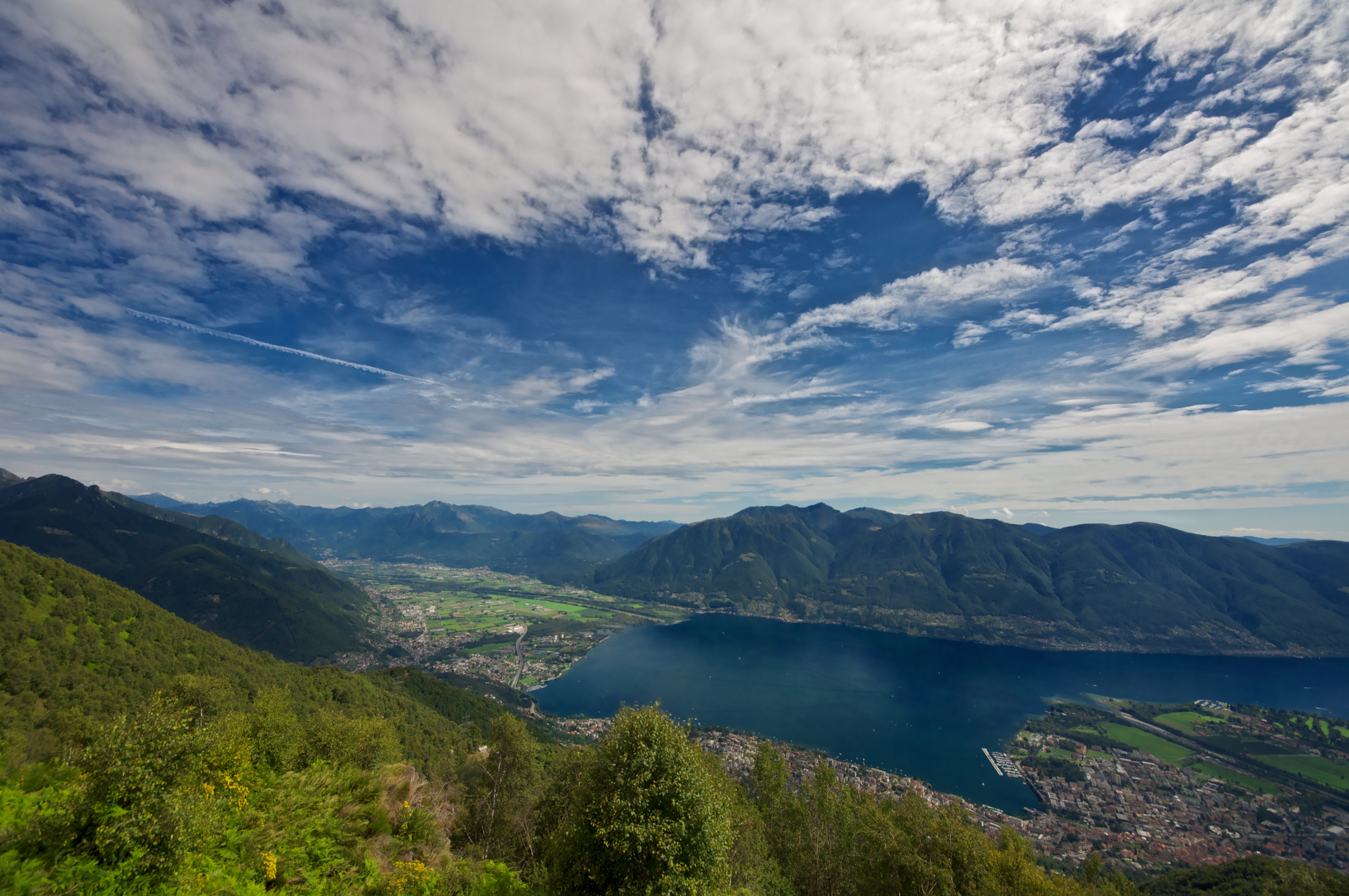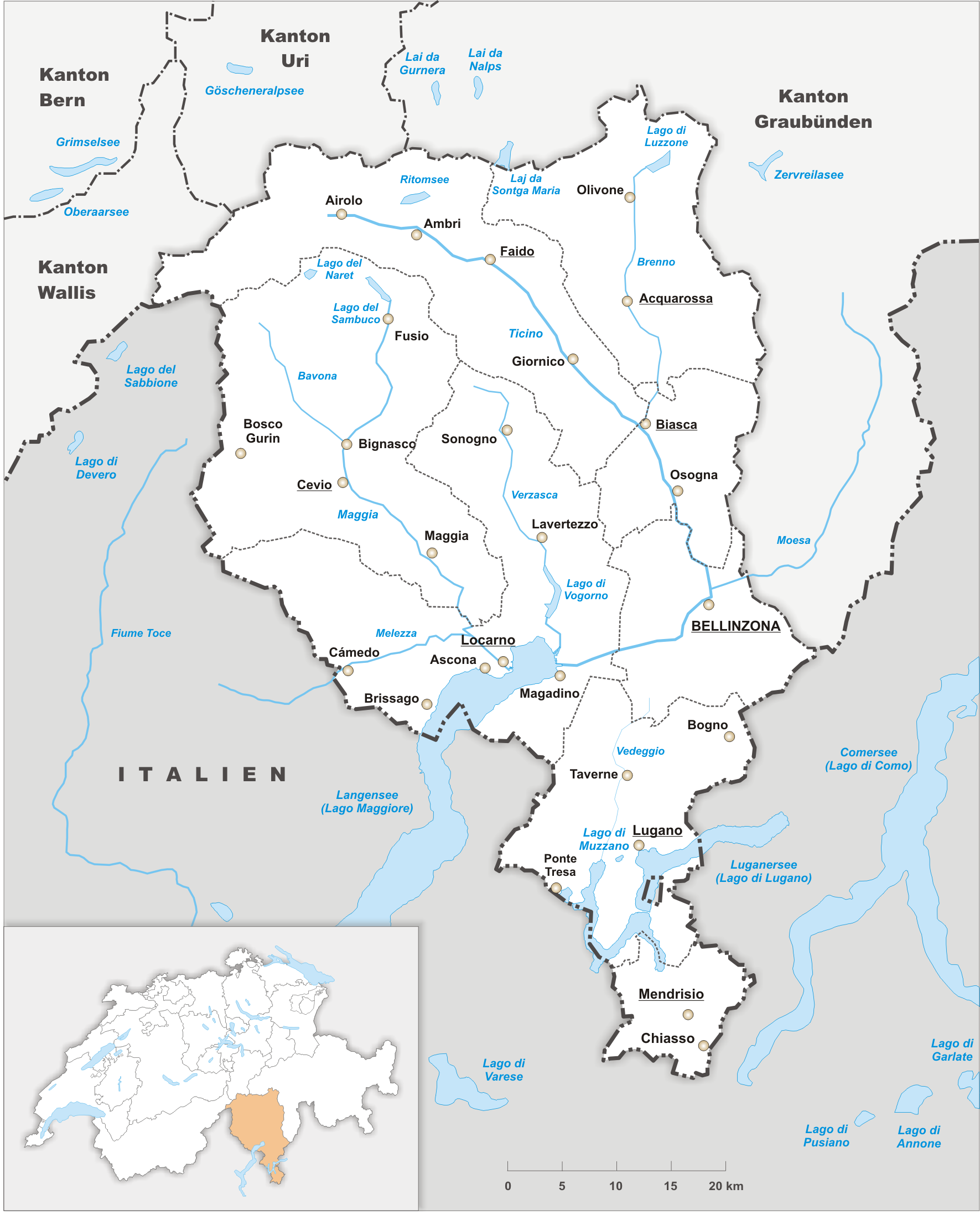|
Locarno Railway Station
Locarno railway station ( it, Stazione di Locarno) serves the city of Locarno, in the canton of Ticino, Switzerland. However, the station is located within the adjacent municipality of Muralto, near the shore of Lake Maggiore. The border between the two municipalities runs along the Torrente Ramogna stream, a short distance to the south and west of the station. Since 1990, Locarno station has been divided into two distinct components, each served by a separately operated railway. At surface level, there is a standard gauge station, operated by the Swiss Federal Railways (SBB CFF FFS). That station is the terminal of a branch line from Giubiasco on the Gotthard Railway. Underground, there is another terminal station, , for the metre gauge Domodossola–Locarno railway, an international rail link operated in Switzerland by the Regional Bus and Rail Company of Canton Ticino ( it, Ferrovie Autolinee Regionali Ticinesi, or FART). Before the station was renovated into this f ... [...More Info...] [...Related Items...] OR: [Wikipedia] [Google] [Baidu] |
Muralto
Muralto is a municipality in the district of Locarno, in the canton of Ticino in Switzerland. Geography Muralto has an area, , of . Of this area, or 71.7% is used for agricultural purposes, while or 3.3% is forested. Of the rest of the land, or 93.3% is settled (buildings or roads) and or 1.7% is unproductive land. Of the built up area, housing and buildings made up 68.3% and transportation infrastructure made up 18.3%. while parks, green belts and sports fields made up 6.7%. Out of the forested land, 1.7% of the total land area is heavily forested and 1.7% is covered with orchards or small clusters of trees. Of the agricultural land, 1.7% is used for growing crops, while 1.7% is used for orchards or vine crops and 68.3% is used for alpine pastures. The municipality is located in the Locarno district, in the agglomeration of Locarno. It lies along Lake Maggiore and is bordered by the Ramogna and Rabissale streams. It was created in 1881, when it separated from Orsel ... [...More Info...] [...Related Items...] OR: [Wikipedia] [Google] [Baidu] |
Ticino
Ticino (), sometimes Tessin (), officially the Republic and Canton of Ticino or less formally the Canton of Ticino,, informally ''Canton Ticino'' ; lmo, Canton Tesin ; german: Kanton Tessin ; french: Canton du Tessin ; rm, Chantun dal Tessin . is one of the 26 cantons forming the Swiss Confederation. It is composed of eight districts and its capital city is Bellinzona. It is also traditionally divided into the Sopraceneri and the Sottoceneri, respectively north and south of Monte Ceneri. Red and blue are the colours of its flag. Ticino is the southernmost canton of Switzerland. It is one of the three large southern Alpine cantons, along with Valais and the Grisons. However, unlike all other cantons, it lies almost entirely south of the Alps, and has no natural access to the Swiss Plateau. Through the main crest of the Gotthard and adjacent mountain ranges, it borders the canton of Valais to the northwest, the canton of Uri to the north and the canton of Grisons to the northea ... [...More Info...] [...Related Items...] OR: [Wikipedia] [Google] [Baidu] |
Railway Stations In Ticino
Rail transport (also known as train transport) is a means of transport that transfers passengers and goods on wheeled vehicles running on rails, which are incorporated in tracks. In contrast to road transport, where the vehicles run on a prepared flat surface, rail vehicles (rolling stock) are directionally guided by the tracks on which they run. Tracks usually consist of steel rails, installed on sleepers (ties) set in ballast, on which the rolling stock, usually fitted with metal wheels, moves. Other variations are also possible, such as "slab track", in which the rails are fastened to a concrete foundation resting on a prepared subsurface. Rolling stock in a rail transport system generally encounters lower frictional resistance than rubber-tyred road vehicles, so passenger and freight cars (carriages and wagons) can be coupled into longer trains. The operation is carried out by a railway company, providing transport between train stations or freight customer facili ... [...More Info...] [...Related Items...] OR: [Wikipedia] [Google] [Baidu] |
Zürich Hauptbahnhof
Zürich Hauptbahnhof (often shortened to Zürich HB, or just HB; ''Zürich Main Station'' or ''Zürich Central Station'') is the largest railway station in Switzerland. Zürich is a major railway hub, with services to and from across Switzerland and neighbouring countries such as Germany, Italy, Austria, and France. The station was originally constructed as the terminus of the Spanisch Brötli Bahn, the first railway built completely within Switzerland. Serving up to 2,915 trains per day, Zürich HB is one of the busiest railway stations in the world. It was ranked as the second best European railway station in 2020. The station can be found at the northern end of the Altstadt, or ''old town'', in central Zürich, near the confluence of the rivers Limmat and Sihl. The station is on several levels, with platforms both at ground and below ground level, and tied together by underground passages and the ShopVille shopping mall. The Sihl passes through the station in a tunnel with r ... [...More Info...] [...Related Items...] OR: [Wikipedia] [Google] [Baidu] |
Regional Bus And Rail Company Of Canton Ticino
The Regional Bus and Rail Company of Ticino ( it, Ferrovie Autolinee Regionali Ticinesi SA, known by its Italian initials FART) is a limited company in the Swiss southern canton of Ticino, which provides the urban and suburban bus network in and around Locarno in Switzerland. It operates the cable cars between Verdasio and Rasa, Ticino, and between Intragna – Pila – Costa on behalf of the owning companies. Together with the Italian company (SSIF) they operate the railway through the Swiss Centovalli and the Italian Valle Vigezzo, which connects the Gotthard trans-Alpine rail route at Locarno railway station with the Simplon trans-Alpine route at Domodossola in Italy. There are 10 stations on the Swiss side of the frontier and 12 stations on the Italian side, the complete rail journey takes about 1 hour and 45 minutes. A formal request for the licensing of a rail network was made by the mayor of Locarno, Francesco Balli, in 1898, but although construction of the Cent ... [...More Info...] [...Related Items...] OR: [Wikipedia] [Google] [Baidu] |
Metre Gauge
Metre-gauge railways are narrow-gauge railways with track gauge of or 1 metre. The metre gauge is used in around of tracks around the world. It was used by European colonial powers, such as the French, British and German Empires. In Europe, large metre-gauge networks remain in use in Switzerland, Spain and many European towns with urban trams, but most metre-gauge local railways in France, Germany and Belgium closed down in the mid-20th century, although many still remain. With the revival of urban rail transport, metre-gauge light metros were established in some cities, and in other cities, metre gauge was replaced by standard gauge. The slightly-wider gauge is used in Sofia. Examples of metre-gauge See also * Italian metre gauge * Narrow-gauge railways A narrow-gauge railway (narrow-gauge railroad in the US) is a railway with a track gauge narrower than standard . Most narrow-gauge railways are between and . Since narrow-gauge railways are usually built with ... [...More Info...] [...Related Items...] OR: [Wikipedia] [Google] [Baidu] |
Gotthard Railway
The Gotthard railway (german: Gotthardbahn; it, Ferrovia del Gottardo) is the Swiss trans-alpine railway line from northern Switzerland to the canton of Ticino. The line forms a major part of an important international railway link between northern and southern Europe, especially on the Rotterdam-Basel-Genoa corridor. The Gotthard Railway Company (german: Gotthardbahn-Gesellschaft) was the former private railway company which financed the construction of, and originally operated, that line. The railway comprises an international main line through Switzerland from Basel (French Bâle) or Zürich to Immensee to Chiasso, together with branches, from Immensee to Lucerne and Rotkreuz, from Arth-Goldau to Zug, and from Bellinzona to Chiasso, via Locarno and Luino. The main line, second highest standard railway in Switzerland, penetrates the Alps by means of the Gotthard Tunnel at above sea level. The line then descends as far as Bellinzona, at above sea level, before climbing ... [...More Info...] [...Related Items...] OR: [Wikipedia] [Google] [Baidu] |
Standard Gauge
A standard-gauge railway is a railway with a track gauge of . The standard gauge is also called Stephenson gauge (after George Stephenson), International gauge, UIC gauge, uniform gauge, normal gauge and European gauge in Europe, and SGR in East Africa. It is the most widely used track gauge around the world, with approximately 55% of the lines in the world using it. All high-speed rail lines use standard gauge except those in Russia, Finland, and Uzbekistan. The distance between the inside edges of the rails is defined to be 1435 mm except in the United States and on some heritage British lines, where it is defined in U.S. customary/Imperial units as exactly "four feet eight and one half inches" which is equivalent to 1435.1mm. History As railways developed and expanded, one of the key issues was the track gauge (the distance, or width, between the inner sides of the rails) to be used. Different railways used different gauges, and where rails of different gauge met – ... [...More Info...] [...Related Items...] OR: [Wikipedia] [Google] [Baidu] |
Lake Maggiore
Lake Maggiore (, ; it, Lago Maggiore ; lmo, label=Western Lombard, Lagh Maggior; pms, Lagh Magior; literally 'Greater Lake') or Verbano (; la, Lacus Verbanus) is a large lake located on the south side of the Alps. It is the second largest lake in Italy and the largest in southern Switzerland. The lake and its shoreline are divided between the Italian regions of Piedmont and Lombardy and the Swiss canton of Ticino. Located halfway between Lake Orta and Lake Lugano, Lake Maggiore extends for about between Locarno and Arona. The climate is mild in both summer and winter, producing Mediterranean vegetation, with many gardens growing rare and exotic plants. Well-known gardens include those of the Borromean and Brissago Islands, that of the Villa Taranto in Verbania, and the Alpinia Botanical Garden above Stresa. Lake Maggiore is drained by the Ticino, a main tributary of the Po. Its basin also collects the waters of several large lakes, notably Lake Lugano (through the Tre ... [...More Info...] [...Related Items...] OR: [Wikipedia] [Google] [Baidu] |
Cantons Of Switzerland
The 26 cantons of Switzerland (german: Kanton; french: canton ; it, cantone; Sursilvan and Surmiran: ; Vallader and Puter: ; Sutsilvan: ; Rumantsch Grischun: ) are the member states of the Swiss Confederation. The nucleus of the Swiss Confederacy in the form of the first three confederate allies used to be referred to as the . Two important periods in the development of the Old Swiss Confederacy are summarized by the terms ('Eight Cantons'; from 1353–1481) and ('Thirteen Cantons', from 1513–1798).rendered "the 'confederacy of eight'" and "the 'Thirteen-Canton Confederation'", respectively, in: Each canton of the Old Swiss Confederacy, formerly also ('lieu/locality', from before 1450), or ('estate', from ), was a fully sovereign state with its own border controls, army, and currency from at least the Treaty of Westphalia (1648) until the establishment of the Swiss federal state in 1848, with a brief period of centralised government during the Helvetic Republic ( ... [...More Info...] [...Related Items...] OR: [Wikipedia] [Google] [Baidu] |





